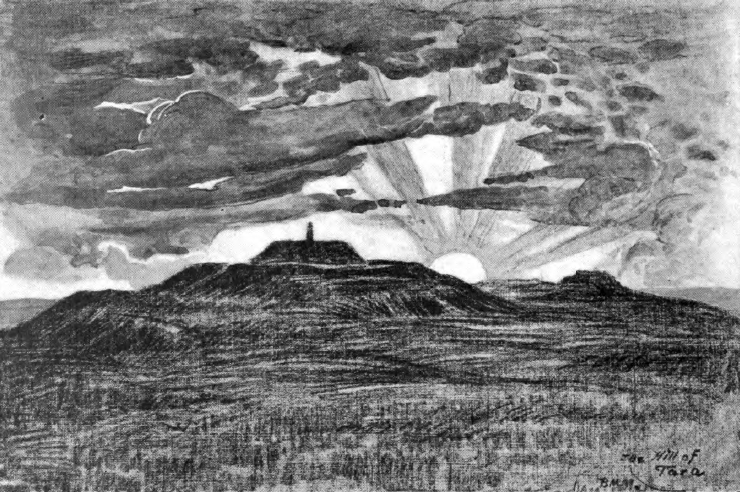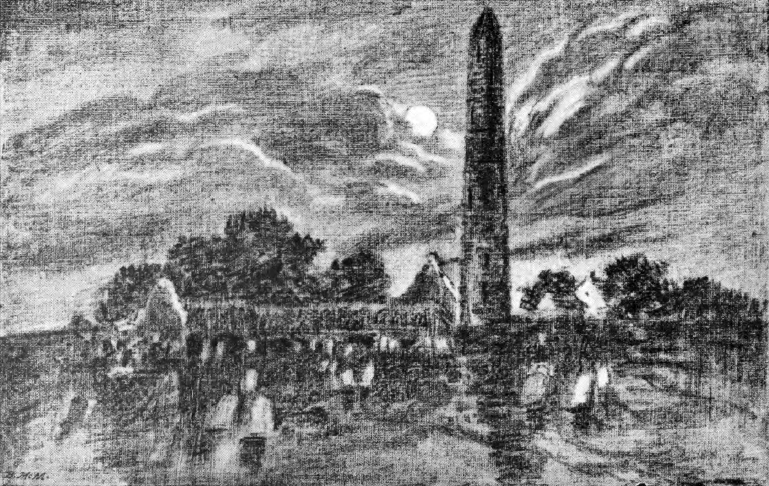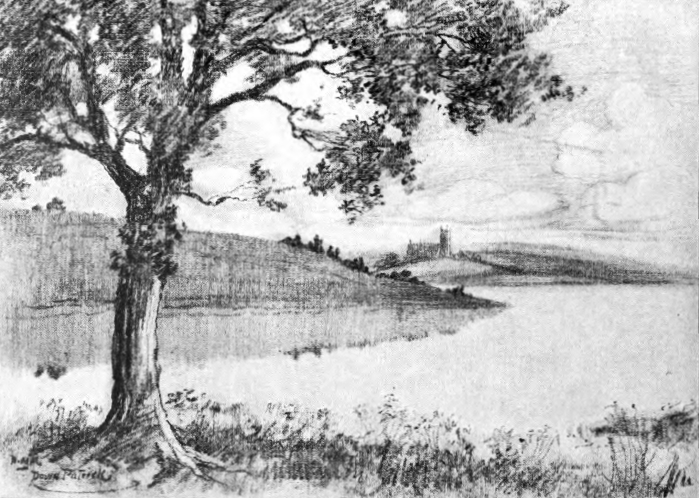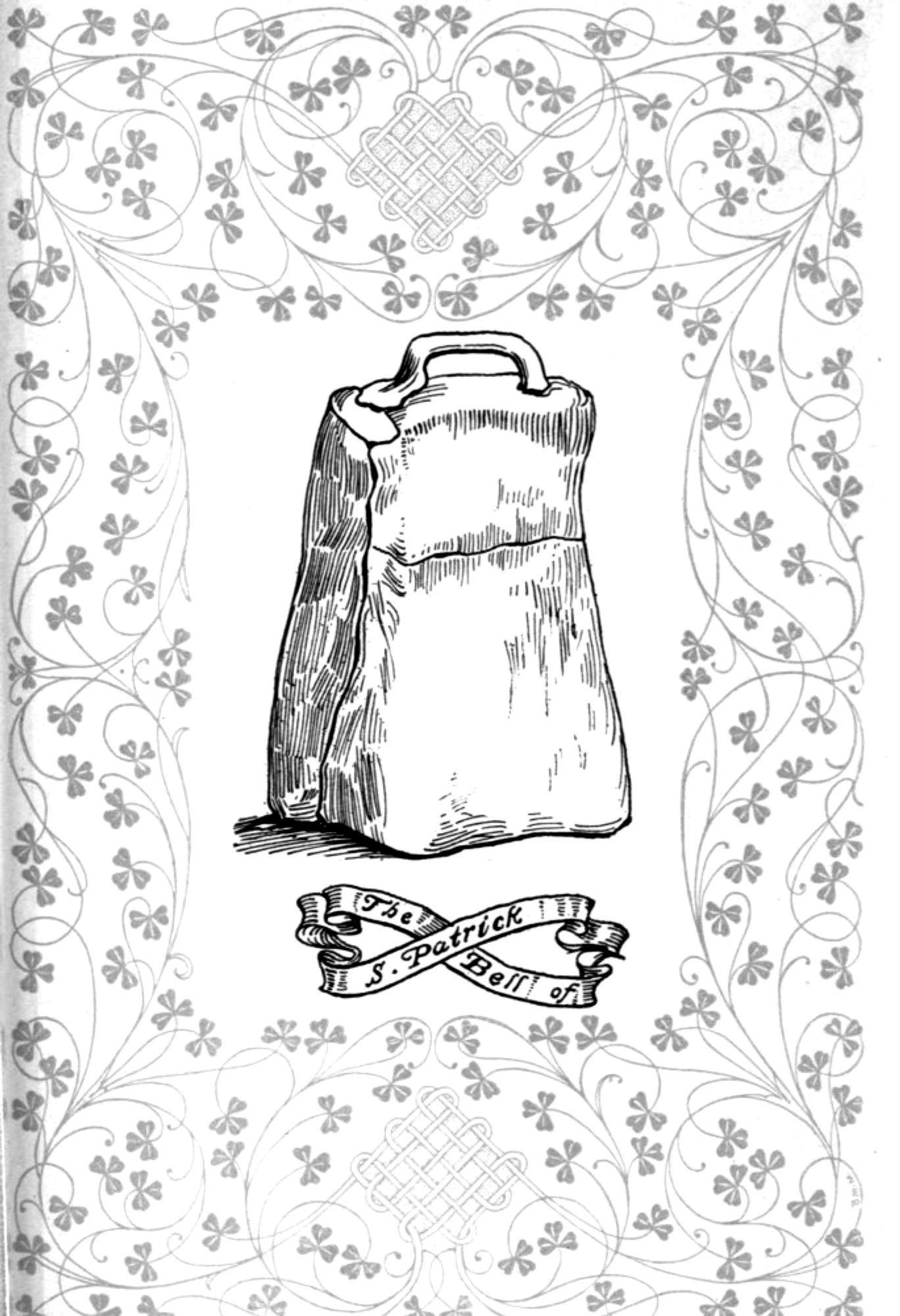| Web
and Book design,
Copyright, Kellscraft Studio 1999-2017 (Return to Web Text-ures) |
 (HOME)
|
|
CHAPTER V. RELIGIOUS ART AND ARCHITECTURE IT has been claimed that Ireland has no distinctive art or architecture, and that the venerable ruins of monasteries and churches, the stone crosses, the curiously interwoven traceries of stone carving, the illuminated manuscripts, and even the famous round towers themselves were all transplanted from a former home; and that the jewelry, bangles, brooches, and rings, which we fondly believe are Celtic, are nothing more than Byzantine or Eastern motives, which found their way to Ireland in some unexplained manner. Whether this be acceptable to the average reader or not, whether he remarks the similarity between certain of the Celtic (?) motives and similar decorative effects in wood and stone known to belong to the Northmen, or whether he prefers to think them an indigenous growth and development of Ireland itself, matters little, in a broad way. Nowhere but in Ireland are there so splendidly executed and preserved traceries of the peculiar sort which is shown in the crosses at Kells and Monasterboice, and, in manuscript, in the “Book of Kells.” Nowhere are there more numerous or more gracefully proportioned round towers than in the Emerald Isle, and nowhere are there more consistently and thoroughly expressed Norman and Gothic forms than in the many ecclesiastical remains which exist to-day, though many of these establishments have not the magnitude or splendour of others elsewhere. The palaces of the Irish kings would have, perhaps, the chief interest for us to-day, did they but exist in more tangible form than reputed sites and mere heaps of stones. From the chronicles we know that they were splendid residential establishments, but not much more. The chief of the palaces whose splendours are celebrated in Irish history were the Palace of Emania, in Ulster, founded or built by Macha, queen of Cinbaeth the First, about the year B.C. 700; Tara, in Meath; Cruachan, in Conact, built by Queen Meave, the beautiful, albeit Amazonian, Queen of the West, about the year B.C. 100; and Ailech, in Donegal, built on the site of an ancient sun-temple, or Tuatha de Danaan, fort-palace. Kincora had not at this period an existence, nor had it for some centuries subsequently. It is said to have never been more than the local residence, though a palatial one, of Brian Boru. Emania, next to Tara the most celebrated of all the royal palaces of ancient Erin, stood on the spot now marked by a large rath called the Navan Fort, two miles to the west of Armagh. It was the residence of the Ulster kings for a period of 855 years. The mound or Grianan of Ailech, upon which, even for hundreds of years after the destruction of the palace, the O’Donnells were elected, installed, or “inaugurated,” is still an object of wonder and curiosity. It stands on the crown of a low hill by the shores of Lough Swilly, about five miles from Londonderry. Royal Tara has been crowned with an imperishable fame in song and story. The entire crest and slopes of Tara Hill were covered with buildings at one time; for not only did a royal palace, the residence of the Ard-Ri (or High King) of Erin, stand there, but, moreover, the legislative chambers, the military buildings, the law courts, and royal universities surrounded it. Of all these nought now remains but the moated mounds or raths that mark where stood the halls within which bard and warrior, ruler and lawgiver, once assembled in glorious pageant. The round towers of Ireland form a subject of curious and speculative interest to him who views them for the first time, as, indeed, they do to most folk, learned or otherwise. The actual invention and construction of these round towers are clothed in much darkness. It had previously been supposed that these extraordinary erections were the work of the Danes, but this position seems to be entirely untenable on many grounds, the chief being that no similar structures exist, or probably ever have existed, in the native country of the Danes, and are, indeed, notably absent from many parts of Ireland where the Danes are known to have been, and yet are found in other localities which were never occupied by the Danes.  THE HILL OF TARA. The great question with regard to these lone towers is whether or no they are, or were, Christian structures. No such monuments are found elsewhere in the known world, except in India or Persia, where, manifestly, their inception was not due to Christian influences. In a way, a very considerable way, they resemble the minarets and turret towerlets of a Cairene or Damascene mosque, where often, in the smaller mosques, at least, the sky-piercing pointed towerlet is the chief and most imposing part of the structure. They may have been signal-towers; they may even have been refuges, though they could not shelter any very great numbers, save in the buildings which often flocked around their bases. In this case they performed much the same functions as the watch-tower or turreted donjon-keep of a castle. At any rate, they were of profound moral and significantly Christian motive, rather than pagan, as he who reads may know. The power of the Church in Ireland grew as it did elsewhere, in France in particular, largely from the foundation of those great secular religious bodies, the abbeys and monasteries. From the time when St. Patrick — carried in slavery from Scotland to Ireland, and subsequently escaping — returned to Ireland in 430-432 to convert the island to Christianity, to the present day, is a long period for any particular institution to have survived and still continue its functions in the same abode. For this reason it is unreasonable to suppose that there is much more than tradition, however well supported, to connect the personality of St. Patrick and his immediate successors with any edifices, however humble or fragmentary, which exist to-day. If they do exist, as popular report would seem to indicate, they most likely are rebuilt structures upon the reputed ancient sites, with the bare possibility that somewhere, down in the cavernous depths of their underpinning, exist the stones of wall and pavement which may have known these early pioneers of Christianity. The art and influences of Christianity, both in Ireland and Scotland, are, from the sixth century, at least, similar as to the development. This was but natural, considering that its great impetus in Scotland only came in the sixth century with the advent of St. Columba, an Irish monk, who was exiled from his own country in 563, and who, coming to Iona at that time, founded a monastery there, and thence passed over to the mainland of Scotland.  ROUND TOWER, ARDMORE. In France, about 646, Arbogast, an Irish monk, founded an oratory, and Gertrude, the daughter of the illustrious Pepin, sent to Ireland for “further persons qualified to instruct the religieuse of the Abbey of Neville, not only in theology and pious studies, but in psalm-singing as well” (“Pour instruire la communate dans le chant des Pseaumes et la meditation des choses saintes.”). Charlemagne, too, placed the universities of Paris and Ticinum under the guidance of two Irishmen, Albin and Clements, who had previously presented themselves, saying that they had learning for sale. The “Monasticum Hibernicum” enumerates many score of abbeys, priories, and other religious establishments in Ireland. One is inclined, in this progressive age, to marvel when he contemplates the universality, among all nations, of that religious zeal which drew its thousands from the elegance and comforts of all classes of society to the sequestered solitude of monastic life. Its history is well known and it is generally recognized that, as the enthusiasm of the Crusades subsided, many influences, which otherwise made for the aggrandizement of the religious orders, became, if not negative, at least impotent. There were, perhaps, some solitaries in the third century, but it was not till after the conversion of Constantine, A. D. 324, that the practice of seeking seclusion from the world became general. Monasticism came to Rome, where St. Patrick received his inspiration, from Egypt, and made its way into Gaul, the monks of St. Martin’s time reproducing the hermit system which St. Anthony had practised in Egypt. Gallic monasticism, during the fifth and sixth centuries, was thoroughly Egyptian in both theory and practice. St. Benedict, the founder of Western monasticism, was born about A. D. 480, and began his religious life as a solitary; but when, early in the sixth century, he “wrote his rule,” “it is noteworthy,” says a French authority, “that he did not attempt to restore the lapsed practices of primitive asceticism, or insist upon any very different scheme of regular discipline.” His rule was dominated by common sense, and individualism was merged in entire submission to the judgment of the superior of the house. Ireland was in the very forefront of the movement, though St. Patrick’s monkish possessions here did not take shape until well into the fifth century; but it was about fifty years, more or less, — authorities differ, — after St. Benedict’s death that Augustine arrived in England (A. D. 597). He and his monks introduced the “Rule” into England. Celtic monasticism did not greatly differ from Western monasticism, which under many names, and with many variations in detail, ever since St. Benedict’s time down to our own day, has been Benedictine at bottom. Congal, Carthag, and Columba continued in St. Patrick’s footsteps, in the sixth century, and carried monastic life to still greater splendour and perfection by their rules and foundations. Then followed throughout Ireland, in a long and splendid succession, many Augustinian, Benedictine, and Cistercian foundations. Besides their glorious ecclesiastical monuments, these bodies were possessed of great wealth in lands, and even in gold. In fact, public generosity, and the opulence of the communities which sheltered them, gave them an almost supreme power, and from obscurity they rose to be all-powerful factors in the life of the times. The prostrating fury of the Reformation moved more slowly here than in England. Ireland had no Wyclif to raise his voice against Rome, and the people in general were, and wished to be, passive subjects of the sovereign pontiff. The Augustinians exceeded in numbers those of any other order in Ireland, but the Arrosians, the Premonstratensians, the Benedictines, the Cistercians (a branch of the Benedictines), the Dominicans (founded by St. Dominic, a Spaniard born about 1070), and the Franciscans (founded by St. Francis of Assisi), and various other orders, were also well established. In addition, the military orders were likewise represented by the Knights Hospitallers, or Knights of St. John, and the Knights Templars, so called from the fact of their original home having been near the Holy Temple. The heads of the monastic houses were the abbot, who governed the abbey, and whose possessions were often so great, in Ireland, as to entitle him to a seat in the parliament amongst the peers; the abbess, who presided over her nuns in much the same manner as the abbot governed his monks; and the prior, who was often the head of a great monastic foundation, and many of whom also had seats in Ireland’s parliament. The military order of Knights Hospitallers also were builders, erecting castles on their manors, such establishments being known as commanderies, while the knight who superintended was styled preceptor, or commendator. Whenever the Knights Templars followed this example of the Knights Hospitallers, their castles were called preceptories. The almoner had the oversight of the alms which were daily distributed; the chamberlain the chief care of the dormitory; the cellarer procured the provisions for the establishment; the infirmarius took care of the sick; the sacrist was in charge of the vestments and utensils, and the precentor, or chantor, directed the choir service. Throughout Ireland, too, were erected many hospitals, friaries, and chantries, for the most part presided over and controlled by members of the higher orders. The friaries had seldom any endowments, being inhabited only by mendicants. Chantries were endowments for the maintenance of one or more priests, who were to daily say mass for the souls of the founder and his family. There were formerly many such in Ireland, usually connected with the larger churches. Hermitages were obviously devoted to the residence of solitaries who secluded themselves from the world and followed an ascetic life of confinement in small cells. This brief résumé is given solely from the fact that it is a commentary on many references which are made elsewhere in this volume, and not in any sense as an assumption that these facts are not otherwise readily accessible to the general reader. It shows, moreover, that monkery was cultivated in Ireland as zealously, and to as great an extent, as in any other nation in Europe, and in addition had, for centuries, supplied many brethren to other establishments throughout the known world, notably to seminaries at Rome, and in Spain, Portugal, and the Low Countries. At the time of the Revolution the number of “regulars” in Ireland was above two thousand, and these all in addition to the regular ecclesiastical establishment and its clergy. The mere attempt to define and describe the cathedrals of Ireland as they exist to-day, or as they existed at the disestablishment, in a work such as this, would be fated to disaster from the very first lines. No brief explanation, even, as to why their numbers were so great, their size so attenuated, or their architectural qualifications so minor, would be satisfactory, and for that reason they must, as a class, be dismissed with a word. The minor county cathedrals of Ireland are almost unknown to all but the historian and archæologist. The larger and more important examples — as in Dublin, Kilkenny, and Cork — are possessed of considerably more than a local repute, though none are architecturally pretentious or great, as compared with the cathedral churches of England or the Continent. The cathedrals of Ireland are in many instances commonplace little countryside churches, insignificant and inaccessible, and many of them, in fact, of no great age or beauty; but they claim, rightly enough, along with many more ambitious edifices elsewhere, the proud distinction of once having been cathedral churches. The largest and most splendid is St. Patrick’s at Dublin. Kilkenny, which next approaches it, falls considerably short of it in size; while St. Patrick itself takes a very low rank indeed as compared with England’s noble minsters. The cruciform plan, with two westerly towers and a huge central spire, — the typical English type, — never fully developed in Ireland. It is stated, indeed, that no such example exists in any church edifice in Ireland, though of cruciform churches with a central tower alone there are examples at Armagh, Dublin (Christchurch), Cashel, Kildare, Kilkenny, and Killaloe. Of cruciform churches with a tower elsewhere than in the centre, specimens are found at Ardfert, Limerick, Clonfert, and Dublin (St. Patrick’s). Waterford had formerly a curious and attractive old cathedral with a square fortified tower placed midway along its southern wall; but what amounted to nothing more than a sheer act of vandalism caused it to be pulled down and a thoroughly hideous, unchurchly, unbeautiful structure — which might be a brew-house but for its steeple — erected in its place. Down Cathedral looks like the typical large parish church of England’s shores, and Derry from the southwest resembles nothing so much as a fortification, not unlike the cathedral of St. Samson at Dol, in Brittany. The restored cathedral of Kildare looks too painfully new to be really beautiful. It must have been much more satisfying as a ruin, judging from contemporaneous prints. The ancient cathedral on the rock at Cashel was unroofed and dismantled in 1748, and its functions taken up by a structure described as “stately Georgian” in style, but which is very ugly. Cloyne Cathedral, though restored and refurbished, has some resemblance left of its former outlines. It is without a spire, and is a long, low, unmajestic building, curiously placed in juxtaposition with a neighbouring round tower, which serves the province of a steeple, at least as a landmark. Killaloe Cathedral is impressively picturesque, perhaps more so by reason of its situation than anything else, though its ample and hardy central tower gives a dignity that otherwise would be lacking. Lismore Cathedral hardly dignifies the title, and has a weak, attenuated little spire which has no element of beauty in its make-up. Otherwise this cathedral is charming, though unpretentious.  DOWNPATRICK. The cathedral at Ross is curious; a long, low structure, mostly nave, surmounted at its westerly termination with a spire which of itself is not attractive, but which mingles with the landscape, from every view-point, in an exceedingly gratifying manner. Clonfert Cathedral is a wonderful old church, one of the most curious and most beautiful in Ireland; its western doorway has a crudity almost barbaric, but it is very beautiful nevertheless. Killala Cathedral is a severe, unelegant structure, but it has a westerly spire of considerable proportions. Kilmacduagh Cathedral is a roofless ruin, kept company by a solitary round tower of a considerable height and remarkable preservation. The diocese was of a very limited extent — but eighteen miles in length by twelve in breadth. Tuam is an ancient, and once a metropolitan, see. The present cathedral is a modern lack-lustre structure, built since 1861. Of all Ireland’s cathedrals, Downpatrick alone has a truly imposing and commanding situation, albeit its dimensions are not grand, nor is it a very ornate or even a splendid structure. Its graveyard professes to be the burial-place of St. Patrick; the simple boulder is there, at any rate, which marks the spot confidently claimed as being that where the bones of the saint rest. In a general way, certain of the characteristics of some of the more notable of Ireland’s cathedrals are thus given. Where great architectural charm or ruined picturesqueness of more than unusual remark are found, they are mentioned elsewhere, but the above fragmentary descriptions should serve to impress upon the mind the comparative simplicity of the ecclesiastical architecture of Ireland. In the large towns are various modern Roman Catholic cathedrals, but their consideration is quite apart from the architectural remains which are here considered. Ulster, the most prosperous division of modern Ireland, has been entirely despoiled of its ancient cathedrals. In the other three divisions or provinces the remains are about equally divided.
 The Bell of St. Patrick The history of church-bells in Ireland is of great moment, in that they are supposed to have been in use as early as the days of St. Patrick. St. Dagans, too, had a great genius, it is said, “in making useful articles of iron, brass, and precious metals for the use of the church.” The celebrated Gildas is said to have sent St. Brigid a small bell which he had cast, while St. Adamnan mentions the use of bells “for the more speedily calling people to church.” St. Nennin’s bell, and those of certain other venerated persons, were frequently tendered to be sworn upon. Iron bells were introduced into the churches constructed in Iceland by Irish monks, and these same missionaries are reputed to have brought their bells from Ireland, for the monasteries which they built in France and Italy, in the seventh and eighth centuries. |